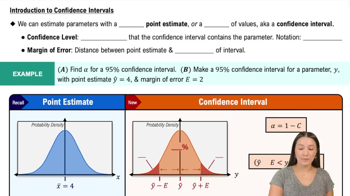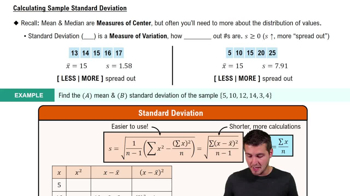Sample Size for Proportion Find the sample size required to estimate the percentage of statistics students who take their statistics course online. Assume that we want 95% confidence that the proportion from the sample is within two percentage points of the true population percentage.
Table of contents
- 1. Intro to Stats and Collecting Data1h 14m
- 2. Describing Data with Tables and Graphs1h 55m
- 3. Describing Data Numerically2h 5m
- 4. Probability2h 16m
- 5. Binomial Distribution & Discrete Random Variables3h 6m
- 6. Normal Distribution and Continuous Random Variables2h 11m
- 7. Sampling Distributions & Confidence Intervals: Mean3h 23m
- Sampling Distribution of the Sample Mean and Central Limit Theorem19m
- Distribution of Sample Mean - Excel23m
- Introduction to Confidence Intervals15m
- Confidence Intervals for Population Mean1h 18m
- Determining the Minimum Sample Size Required12m
- Finding Probabilities and T Critical Values - Excel28m
- Confidence Intervals for Population Means - Excel25m
- 8. Sampling Distributions & Confidence Intervals: Proportion1h 12m
- 9. Hypothesis Testing for One Sample3h 29m
- 10. Hypothesis Testing for Two Samples4h 50m
- Two Proportions1h 13m
- Two Proportions Hypothesis Test - Excel28m
- Two Means - Unknown, Unequal Variance1h 3m
- Two Means - Unknown Variances Hypothesis Test - Excel12m
- Two Means - Unknown, Equal Variance15m
- Two Means - Unknown, Equal Variances Hypothesis Test - Excel9m
- Two Means - Known Variance12m
- Two Means - Sigma Known Hypothesis Test - Excel21m
- Two Means - Matched Pairs (Dependent Samples)42m
- Matched Pairs Hypothesis Test - Excel12m
- 11. Correlation1h 6m
- 12. Regression1h 50m
- 13. Chi-Square Tests & Goodness of Fit1h 57m
- 14. ANOVA1h 57m
8. Sampling Distributions & Confidence Intervals: Proportion
Confidence Intervals for Population Proportion
Problem 7.9b
Textbook Question
Alcohol in Children’s Movies Listed below is a simple random sample of times (seconds) that animated children’s movies showed the use of alcohol (based on Data Set 20 “Alcohol and Tobacco in Movies” in Appendix B).
b. Are the requirements for constructing a 95% confidence interval estimate of the population standard deviation satisfied? If so, construct that confidence interval.

 Verified step by step guidance
Verified step by step guidance1
Step 1: Verify the requirements for constructing a confidence interval for the population standard deviation. The requirements include: (a) the sample must be a simple random sample, and (b) the population must follow a normal distribution. Since the problem states that the sample is random, we need to check whether the data appears to be normally distributed. This can be done by creating a histogram or performing a normality test.
Step 2: Calculate the sample standard deviation (s) using the formula: s = sqrt((Σ(x_i - x̄)^2) / (n - 1)), where x_i represents each data point, x̄ is the sample mean, and n is the sample size. First, compute the sample mean (x̄) by summing all the data points and dividing by the sample size.
Step 3: Determine the degrees of freedom (df) for the chi-square distribution. The degrees of freedom are calculated as df = n - 1, where n is the sample size.
Step 4: Use the chi-square distribution to find the critical values for a 95% confidence interval. The critical values are obtained from a chi-square table or using statistical software, corresponding to the lower and upper tails of the distribution (α/2 and 1 - α/2, where α = 0.05).
Step 5: Construct the confidence interval for the population standard deviation using the formula: CI = [sqrt((df * s^2) / χ²_upper), sqrt((df * s^2) / χ²_lower)], where χ²_upper and χ²_lower are the critical values from the chi-square distribution, df is the degrees of freedom, and s is the sample standard deviation.
 Verified video answer for a similar problem:
Verified video answer for a similar problem:This video solution was recommended by our tutors as helpful for the problem above
Video duration:
6mPlay a video:
Was this helpful?
Key Concepts
Here are the essential concepts you must grasp in order to answer the question correctly.
Confidence Interval
A confidence interval is a range of values, derived from sample statistics, that is likely to contain the true population parameter with a specified level of confidence, typically 95%. It provides an estimate of uncertainty around the sample mean or standard deviation, allowing researchers to infer about the population from which the sample was drawn.
Recommended video:

Introduction to Confidence Intervals
Standard Deviation
Standard deviation is a measure of the amount of variation or dispersion in a set of values. A low standard deviation indicates that the values tend to be close to the mean, while a high standard deviation indicates that the values are spread out over a wider range. It is crucial for constructing confidence intervals as it reflects the variability in the data.
Recommended video:
Guided course

Calculating Standard Deviation
Simple Random Sample
A simple random sample is a subset of individuals chosen from a larger set, where each individual has an equal chance of being selected. This method helps ensure that the sample is representative of the population, which is essential for making valid inferences about the population parameters, such as the mean or standard deviation.
Recommended video:

Sampling Distribution of Sample Proportion

 5:45m
5:45mWatch next
Master Constructing Confidence Intervals for Proportions with a bite sized video explanation from Patrick
Start learningRelated Videos
Related Practice
Textbook Question
